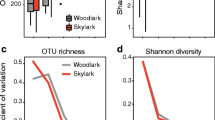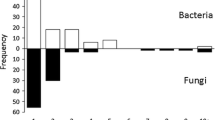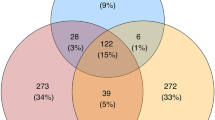Abstract
The relationship between microorganisms and birds has received increased attention recently. The state of knowledge of this relationship, however, is based largely on examination of sick or dead birds, and knowledge of the prevalence and community structure and function of microbes in healthy wild populations is limited. Using carbon substrate utilization profiles, microbial communities were examined in 91 cloacal samples from 14 species within apparently healthy summer and winter passerine populations. Within each season, gradient lengths and eigenvalues from ordination analyses suggested that many samples differed in their carbon substrate utilization and several had very different communities. Cloacal microbe carbon utilization profiles were distinguishable among host species, season-specific diet, and study site in the ordination analyses. However, these patterns were only observed for the analysis of the summer data set. The results of this study support the idea that the avian host’s microbial community, relative to carbon substrate utilization, is related to host diet. Previously, this pattern had only been reported for potential pathogens isolated from the avian cloaca. Study site–specific patterns in the ordination analysis suggest that environmental conditions at a particular study site may influence cloacal microbial communities in birds. Results of this study indicate that examination of community-level physiological profiles may be a useful technique for distinguishing among avian cloacal samples, similar to that already established for discriminating aqueous and soil samples. Future studies that correlate microbe physiological profiles to condition-based indices of avian hosts may be most useful for eventually using the profile as an indicator of environmental conditions experienced by hosts.



Similar content being viewed by others
References
HP Bedbury GE Duke (1983) ArticleTitleCecal microflora of turkeys fed low or high fiber diets: enumeration, identification, and determination of cellulolytic activity Poult Sci 62 675–682 Occurrence Handle6306633
CR Bell MA Holder-Franklin M Franklin (1982) ArticleTitleCorrelations between predominant heterotrophic and physio-chemical water quality factors in two Canadian rivers Appl Environ Microbiol 43 269–283
EJ Braun CE Campbell (1989) ArticleTitleUric acid decomposition in the lower gastrointestinal tract J Exp Zool Suppl 3 70–74 Occurrence Handle10.1002/jez.1402520512 Occurrence Handle2575131
MC Brittingham SA Temple RM Duncan (1988) ArticleTitleA survey of the prevalence of selected bacteria in wild birds J Wildlife Dis 24 299–307
JS Buyer LE Drinkwater (1997) ArticleTitleComparison of substrate utilization assay and fatty acid analysis of soil microbial communities J Microbiol Methods 30 3–11 Occurrence Handle10.1016/S0167-7012(97)00038-9
SH Cousins (1991) ArticleTitleSpecies diversity measurement: choosing the right index Trends Ecol Evol 6 190–192 Occurrence Handle10.1016/0169-5347(91)90212-G
KW Cummins MJ Klug (1979) ArticleTitleFeeding ecology of stream invertebrates Ann Rev Ecol Syst 10 147–172 Occurrence Handle10.1146/annurev.es.10.110179.001051
PR Ehrlich DS Dobkin D Wheye (1988) The Birder’s Handbook: A Field Guide to the Natural History of North American Birds Simon and Schuster London
M Gamo T Shoji (1999) ArticleTitleA method of profiling microbial communities based on a most-probable-number assay that uses BIOLOG plates and multiple sole carbon sources Appl Environ Microbiol 65 4419–4424 Occurrence Handle10508069
JL Garland (1996) ArticleTitleAnalytical approaches to the characterization of samples of microbial communities using patterns of potential C source utilization Soil Biol Biochem 28 213–221 Occurrence Handle10.1016/0038-0717(95)00112-3
JL Garland AL Mills (1991) ArticleTitleClassification and characterization of heterotrophic microbial communities on the basis of patterns of community level sole-carbon-source utilization Appl Environ Microbiol 57 2351–2359
JL Garland AL Mills (1999) ArticleTitleImportance of pattern analysis in community level physiological profiles (CLPP): a reply to the letter from P.J.A. Howard Soil Biol Biochem 31 1201–1202 Occurrence Handle10.1016/S0038-0717(97)00151-X
JL Garland AL Mills JS Young (2001) ArticleTitleRelative effectiveness of kinetic analysis vs single point readings for classifying environmental samples based on community level physiological profiles (CLPP) Soil Biol Biochem 33 1059–1066 Occurrence Handle10.1016/S0038-0717(01)00011-6 Occurrence Handle12194184
G Glunder (1981) ArticleTitleOccurrence of Enterobacteriaceae in feces of granivorous passeriform birds Avian Dis 25 195–198 Occurrence Handle7271656
CJ Grossman (1985) ArticleTitleInteractions between the gonadal steroids and the immune system Science 227 257–261 Occurrence Handle3871252
SK Haak H Garchow MJ Klug LJ Forny (1995) ArticleTitleAnalysis of factors affecting the accuracy, reproducibility, and interpretation of microbial community carbon source utilization patterns Appl Environ Microbiol 61 1458–1468
DA Jackson KM Somers (1991) ArticleTitlePutting things in order: the ups and downs of detrended correspondence analysis Am Nat 137 704–712
RHG Jongman CJF ter Braak OFR Tongeren ParticleVan (1995) Data Analysis in Community and Landscape Ecology Cambridge University Press Cambridge, UK
G Kapperud O Olsvik (1982) ArticleTitleIsolation of enterotoxigenic Yersinia enteroclitica from birds in Norway J Wildlife Dis 18 247–248
LN Locke RB Shillinger T Jareed (1973) ArticleTitleSalmonellosis in passerine birds in Maryland and West Virginia J Wildlife Dis 9 144–145
MP Lombardo PA Thorpe R Cichewicz M Henshaw C Millard C Steen TK Zeller (1996) ArticleTitleCommunities of cloacal bacteria in tree swallow families Condor 98 167–172
NS Mair (1973) ArticleTitleYersiniosis in wildlife and its public health implications J Wildlife Dis 9 64–69
L Margulis D Chase R Guerrero (1986) ArticleTitleMicrobial communities BioScience 36 160–170 Occurrence Handle11542124
B McCune MJ Mefford (1999) PC-ORD. Multivariate analysis of ecological data, Version 4 MjM Software Design Gleneden Beach, OR
GC Mead (1989) ArticleTitleMicrobes of the avian cecum: types present and substrates utilized J Exp Zool Supplement 3 48–54 Occurrence Handle10.1002/jez.1402520508
MR Miller (1976) ArticleTitleCecal fermentation in mallards in relation to diet Condor 78 107–111
AL Mills JL Garland (2002) Application of physiological profiles to assessment of community properties CJ Hurst RL Crawford GR Knudson MJ McInerney LD Stetzenbach (Eds) Manual of Environmental Microbiology ASM Press Washington, DC 135–146
TK Mills MP Lombardo PA Thorpe (1999) ArticleTitleMicrobial colonization of the cloacae of nestling tree swallows Auk 116 947–956
PR Minchin (1987) ArticleTitleAn evaluation of the relative robustness of techniques for ecological ordination Vegetatio 69 89–107 Occurrence Handle10.1007/BF00038690
PA Nuttall (1997) Viruses, bacteria, and fungi of birds DH Clayton J Moore (Eds) Host Parasite Evolution: General Principles and Avian Models Oxford University Press New York 271–302
HC Pinkart DB Ringelberg YM Piceno SJ Macnaughton DC White (2002) Biochemical approaches to biomass measurements and community structure analysis CJ Hurst RL Crawford GR Knudson MJ McInerney LD Stetzenbach (Eds) Manual of Environmental Microbiology Asm Press Washington, DC 101–113
Poole A, Gill F (Eds.) (1993–2002) The Birds of North America. Academy of Natural Sciences, Philadelphia, the American Ornithologists’ Union, Washington, DC, and The Birds of North American, Philadelphia
P Pyle (1997) Identification Guide to North American Birds. Part I: Columbidae to Ploceidae Slate Creek Press Bolinas, CA
PT Redig (1989) ArticleTitleThe avion ceca: obligate combustion chambers or facultative afterburners? The conditioning influence of diet J Exp Zool Suppl 3 66–69 Occurrence Handle10.1002/jez.1402520511 Occurrence Handle2575130
InstitutionalAuthorNameSAS Institute Inc. (1989) SAS/STAT User’s Guide, vol 2 EditionNumber4 SAS Institute Cary, NC
R Stewart TB Rambo (2000) ArticleTitleCloacal microbes in house sparrows Condor 102 679–684
D Wartenberg S Ferson FJ Rohlf (1987) ArticleTitlePutting things in order: a critique of detrended correspondence analysis Am Nat 129 434–448 Occurrence Handle10.1086/284647
Acknowledgments
The Judd Hill Foundation of Arkansas State University supported this work. We especially thank J. Bouldin, R. Buchanan, A. Christian, C. Cooper, A. Grippo, V. Harwood, J. Maul, R. Maul, P. Scheuerman, and two anonymous reviewers for constructive and insightful comments and suggestions on earlier drafts of the manuscript and M. Scott and L. Barnett for field assistance. B. Baker, M. Gibson, G. Miller, and J. Moon, Jr., provided or facilitated access to study sites for which we are most appreciative.
Author information
Authors and Affiliations
Corresponding author
Rights and permissions
About this article
Cite this article
Maul, J., Gandhi, J. & Farris, J. Community-Level Physiological Profiles of Cloacal Microbes in Songbirds (Order: Passeriformes): Variation Due to Host Species, Host Diet, and Habitat. Microb Ecol 50, 19–28 (2005). https://doi.org/10.1007/s00248-004-0076-9
Received:
Accepted:
Published:
Issue Date:
DOI: https://doi.org/10.1007/s00248-004-0076-9




